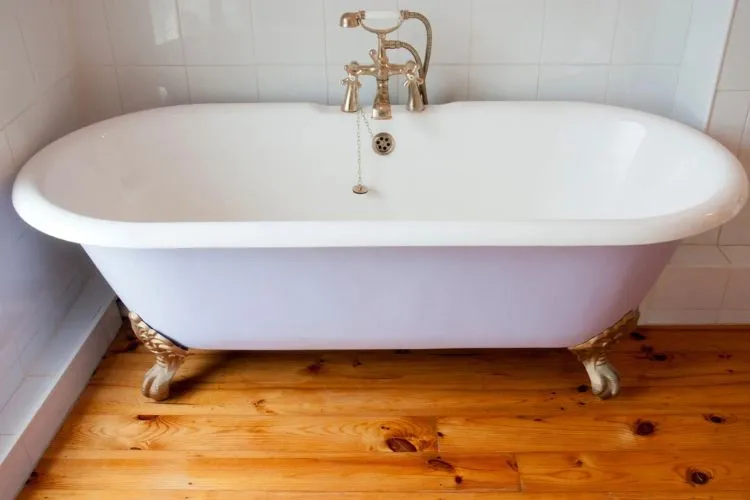Replacing a bathtub is a common home improvement project, but understanding the time it takes can be crucial for homeowners.
So, exactly how long does it take to replace a bathtub?
Let’s dive together into this comprehensive guide as we explore the factors that determine the duration of the process.

From selecting the perfect bathtub to the skilled labor involved, we’ll walk you through the timeline, ensuring that you’re well-prepared for the task ahead.
How long does it take to replace a bathtub?
Replacing a bathtub typically requires two days, assuming all the necessary materials and a professional plumber or contractor are readily available.
The first day involves removing the old bathtub. This can take anywhere from 4-6 hours, depending on the complexity of the existing setup. It can be a meticulous job as it requires turning off the water, disconnecting the drain, removing any caulk surrounding the tub, and possibly cutting the tub into pieces for removal.
After the old bathtub is taken out, the area is cleaned and prepared for the new bathtub installation. This includes verifying the level of the floor, checking the condition of the plumbing, and making any necessary adjustments to the drain assembly and other plumbing fixtures.
The second day focuses on the installation of the new bathtub. This usually takes between 4-8 hours based on the type of replacement tub and the specifics of the installation. It involves setting the new tub in place, securing it, making all the necessary drain and plumbing connections, and re-caulking the edge.
The estimated two days above are likely to apply unless there are unforeseen problems — such as the need for replacing pipes or rotting subfloor. Such issues may add a day or two to the timeline.
Remember that while these steps may sound straightforward, replacing a bathtub implies a level of expertise which may be beyond the average DIYer. It involves plumbing, carpentry and possibly some understanding of electrical systems if the bathtub includes jets or inline heaters.
How long does it take to replace a tub with a shower?
Replacing a tub with a shower generally takes around two to three days, given the right conditions and a professional handy on site.
The first step would involve removing the old tub, which typically takes half a day. The area is then cleaned and prepped for the installation of the shower pan and plumbing adjustments. This might take another few hours or even extend into the second day.

The second day primarily focuses on installing the shower unit, including the walls and enclosure. If the shower is a custom tiled one, it might need more time for tile setting and grouting.
The last part is installation of fixtures, shower doors and sealing edges, which can be done on the third day. Delays could arise if any structural issues or plumbing repairs pop up in the process. This assumes a standard bathroom configuration and may vary on individual factors.
Is it a big job to replace a bathtub?
Replacing a bathtub is considered a significant job due to its complexity and the range of skills required. Here’s an outline of why it’s a big job:

Plumbing Skills
Changing a bathtub is not just a simple swap; it involves several plumbing tasks. This can include disconnecting and reconnecting water supply lines, adjusting or replacing the drain and overflow unit, ensuring all connections are watertight, and sometimes rerouting plumbing to fit the new tub.
Demolition and Removal
Bathtubs are large, often heavy, and sometimes integrated into the bathroom structure. Removing the old tub may require demolition of surrounding tiles, drywall, or even a part of the framing, then physically taking the bathtub out of the bathroom, which could involve cutting it into sections for easier removal.
Fit and Finish
The new bathtub has to fit into the existing space, which sometimes requires modification of the area or the supports underneath the tub. Following installation, the job is completed with sealing, caulking, and possibly the installation of a new surround or tiling, which need to be done meticulously to prevent future water damage.
Technical and Structural Considerations
The weight of a new tub might demand reinforcement of the underlying floor structure. Also, building codes have to be considered, especially regarding plumbing changes.
Time Commitment
It demands a considerable amount of time – usually two or more days when done by a professional. For a DIYer, this can stretch much longer due to the learning curve and possible unforeseen complications.
Potential for Unexpected Issues
Once the old bathtub is removed, there might be hidden water damage, mold, or structural issues that need to be addressed before the installation can proceed.
Costs
The cost can become substantial when considering the price of the new bathtub, materials for installation, any tools needed, and the potential necessity to hire professionals to ensure proper installation.
Skills Required
A range of competencies is essential, including plumbing, carpentry, possibly electrical (for whirlpool or air tubs), and finishing skills like tile laying and grouting.
For these reasons, replacing a bathtub is not just a straightforward swapping job; it’s a multi-faceted home improvement project that can greatly impact the functionality and design of a bathroom.
What is the labor cost to remove and replace a bathtub?
The labor cost for removing and replacing a bathtub fluctuates based on several factors. On average, it ranges between $500 and $1,500.
The type of bathtub is one significant cost determinant. Labor for removing and installing a drop-in bathtub, being less labor-intensive, generally costs between $500 and $800. In contrast, built-in or corner tubs, which are more complex, can range from $800 to $1,500.
The condition of the existing tub can also impact labor costs. If the old tub is challenging to remove due to extensive caulking, rust, or damage, the removal process might result in higher labor costs. Conversely, a tub that can be more easily lifted out will likely cost less.
Other influencing factors include the specifics of the installation. A simple like-for-like replacement usually costs less compared to moving the drain/faucet placement, changing the tub size/shape, or adjusting the location/configuration of plumbing. Such significant alterations can add an extra $100 to $300 to the labor costs.
Lastly, the project’s location can affect labor costs as well, usually tending to be higher in large metro areas.
Is it worth it to replace a bathtub?
Replacing a bathtub can be a significant investment in terms of time, effort, and money. Whether or not this venture is worthwhile depends on several factors.

When replacing a bathtub is worth it:
- Damage or Wear: If the bathtub is extensively cracked, leaking, or has persistent mold and mildew issues that are difficult to clean or pose health hazards, replacing it becomes necessary.
- Updating the Bathroom: While remodeling for a more modern look or to improve the functionality of the space, replacing an outdated bathtub can significantly enhance the bathroom’s aesthetics and usability.
- Improving Home Value: Before selling a home, updating the bathroom, including a new bathtub, can increase the property’s appeal and can potentially provide a good return on investment.
- Accessibility Needs: Replacing a bathtub with a walk-in shower or tub can be worth it for those with mobility issues or planning to age in place.
When replacing a bathtub may not be worth it:
- Minor Issues: For superficial blemishes or small cracks, often a repair kit can resolve the problem at a fraction of the cost of replacement.
- Limited Budget: The process can be expensive; if you have a tight budget, it might not be the right time to undertake such a renovation, especially if compromises in quality would have to be made.
- Temporary Housing: If you’re not planning on staying in your current home for long, investing in such a significant change might not offer tangible benefits before moving.
- Unsure Plans: When you’re uncertain about your future bathroom design plans or overall interior design goals, it may be better to wait before making a permanent change like replacing a bathtub.
Ultimately, the decision should hinge on the condition of the current bathtub, your budget, how much value the replacement would add either to your life or your home value, and your long-term intentions for the property.
Conclusion:
Replacing a bathtub is a significant project that demands a considerable investment of time, effort, and money. Typically, the procedure requires two or more days when executed by a professional, depending on the project’s complexity and possible unforeseen challenges.
Whether for aesthetic enhancement, increased functionality, or necessity due to wear and tear, it’s crucial to evaluate the time commitment, potential inconveniences, and costs involved.
With careful planning, patience, and competent professionals on hand, you can successfully replace a bathtub and rejuvenate the feel and look of your bathroom.


